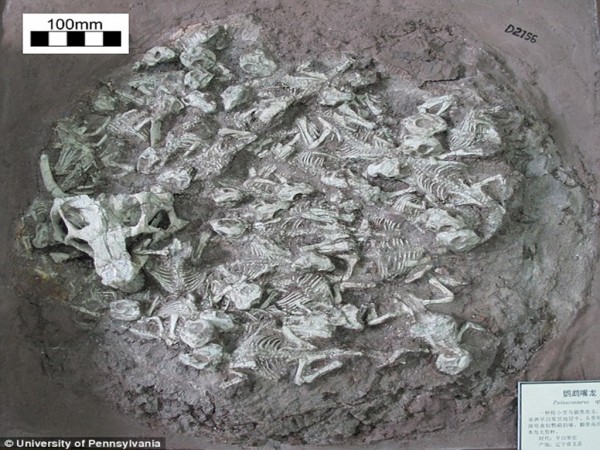Chinese Dinosaur Fossils had Babysitter, Paleontologists Find
| Paula Marie Navarra | | Aug 28, 2014 12:14 PM EDT |
(Photo : University of Pennsylvania) The remains of 25 dinosaurs were found in a single rock slab from northeastern China. Their positioning shows they all died together, possibly as a result of a violent landslide caused by a volcanic eruption. One of the remains is that of an older dinosaur.
Who would have thought that humans weren't the only ones to have babysitters?
Paleontologists found a dinosaur "babysitter" in a rock slab with 24 young dinosaurs it seemed to be watching over.
They found the 120 million-year-old fossils in the Lujiatan beds in the Yixian Formation at Liaoning Province, in northeastern China.
Like Us on Facebook
Brandon P. Hedrick from the University of Pennsylvania said that when he saw the photo of the dinosaurs, he wanted to have an in-depth exploration of it.
Their findings showed that the rock where the fossils were preserved were composed of volcanic materials.
Researchers believe that the dinosaurs' death likely came from lahar - a flood of volcanic debris - because there was no evidence of heat damage to the bones.
Lahar is a mixture of slurry pyroclastic material, rocky debris and water that is commonly associated with heavy rains after a volcanic eruption.
They explained that the younger dinosaurs appeared to be similar in size and were already hatched by the time of their death
Hedrick said the fossils have well-developed bone ends indicating they were capable of moving around.
They said the dinosaur babysitter was firmly embedded in the same layer of rock as the young dinosaurs.
Researchers noticed that two of the young dinosaurs were intertwined with the skulls which showed that the babysitter was closely associated to them.
The babysitter's skull was about 4.5 inches long, which indicated that the dinosaur was around 4 to 5 years old, researchers said.
The dinosaur babysitter was a Psittacosaurus Lujiatunensis that could not reproduce until they were 8 years old, so it could not be the parent, but more probably an older brother or sister that was helping take care of its siblings, researchers believe.
The American researchers collaborated with Dalian Museum of Natural History in China where the specimen are on display. The findings appear on the journal Cretaceous Research.
TagsPaleontology, Fossils, Science
©2015 Chinatopix All rights reserved. Do not reproduce without permission
EDITOR'S PICKS
-

Did the Trump administration just announce plans for a trade war with ‘hostile’ China and Russia?
-

US Senate passes Taiwan travel bill slammed by China
-

As Yan Sihong’s family grieves, here are other Chinese students who went missing abroad. Some have never been found
-

Beijing blasts Western critics who ‘smear China’ with the term sharp power
-

China Envoy Seeks to Defuse Tensions With U.S. as a Trade War Brews
-

Singapore's Deputy PM Provides Bitcoin Vote of Confidence Amid China's Blanket Bans
-

China warns investors over risks in overseas virtual currency trading
-

Chinese government most trustworthy: survey
-

Kashima Antlers On Course For Back-To-Back Titles
MOST POPULAR
LATEST NEWS
Zhou Yongkang: China's Former Security Chief Sentenced to Life in Prison

China's former Chief of the Ministry of Public Security, Zhou Yongkang, has been given a life sentence after he was found guilty of abusing his office, bribery and deliberately ... Full Article
TRENDING STORY

China Pork Prices Expected to Stabilize As The Supplies Recover

Elephone P9000 Smartphone is now on Sale on Amazon India

There's a Big Chance Cliffhangers Won't Still Be Resolved When Grey's Anatomy Season 13 Returns

Supreme Court Ruled on Samsung vs Apple Dispute for Patent Infringement

Microsoft Surface Pro 5 Rumors and Release Date: What is the Latest?










